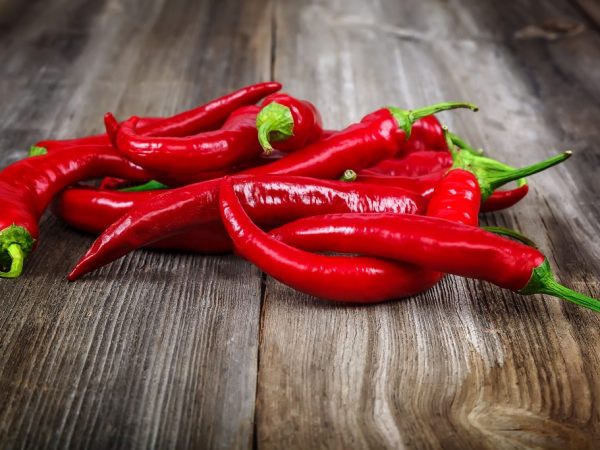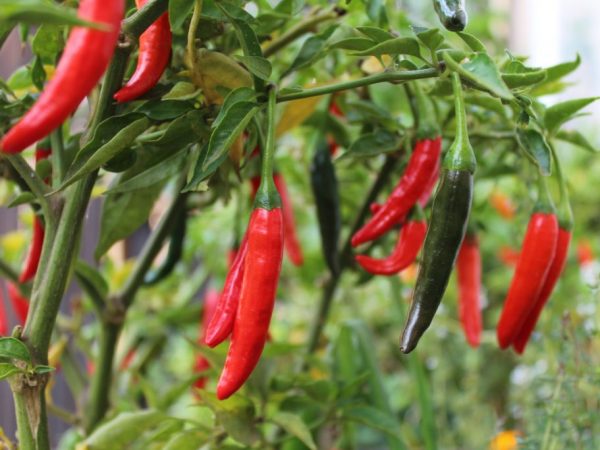Characteristics of Tsitsak salad pepper
Tsitsak pepper is one of the varieties of hot red pepper. Tsitsak is undemanding in leaving, thanks to which he gained his popularity.

Characteristics of Tsitsak salad pepper
Characteristics of the variety
Tsitsak pepper loves warmth. In northern regions with predominantly low temperatures, it is grown only under polyethylene coverings. Bushes must be located on the sunny side. It is advisable that other plants do not create shade around.
Characteristic features of Tsitsak pepper:
- high productivity;
- the possibility of long-term storage of fruits;
- resistance to fungal diseases;
- low calorie content;
- relative resistance to frost (down to -20 ° C);
- the content of many useful microelements.
The vegetable crop has an average ripening period. The fruits mature 110-125 days after planting.
Peppers can be planted next to sweet varieties, dill, garlic, parsley.
Description of bushes
The Tsitsak bush has a medium foliage. The average height of the bush is 80-100 cm. The stem is strong. Its length reaches 60-70 cm.
Leaves are oblong, elongated. They are distinguished by a bright green color. The edges are pointed.
For 1 sq.m. it is recommended to plant no more than 6-7 bushes. This is to prevent damage to the root system.
Description of fruits
- the pulp is very fleshy;
- average level of pungency;
- conical shape;
- fleshy walls;
- ribbed surface;
The average weight of 1 fruit is up to 30-50 g. The length reaches 15-20 cm.
Very hot spices are made from the fruits of the Tsitsak pepper. This vegetable is great for preserving. Pickled salty Tsitsak is often used as a snack.
Care
Growing seedlings

Proper care will ensure you have a good harvest
To obtain high-quality and healthy seedlings, it is necessary to germinate the seeds before planting. This requires gauze soaked in water. It must be folded several times. Seeds are placed inside and removed in a warm place for 5-6 days.
You need to sow seeds in March in pre-prepared soil. It is necessary to mix drainage and nutrient soil in a 2: 1 ratio. Add fresh turf and well-rotted compost to this mixture. The prepared soil must be poured into the box. After that, the future seedlings are covered with film or glass to create a greenhouse effect.
During the daytime, the box with sprouts must be left in a warm room with a temperature of 24-26 ° C. Move the seedlings to a cooler place at night with an average temperature of 13-16 ° C.
Seedling picking
It is necessary to dive the sprouts after the appearance of the first leaves. This must be done very carefully so as not to damage the roots of the plant.
The seedlings are transferred into prepared cups with peat and earth. After germination, it is transplanted into open ground.
Top dressing
The sprouts need to be fed with a small amount of nitrogen fertilizers. When each stem of the seedling is covered with 3 leaves, you need to add phosphorus and potassium fertilizers.
In order for the bushes to grow actively, they need to be fed with organic fertilizers. The best solution is wood ash.Top dressing is carried out 1-2 times a week.
Watering
Water the plant regularly, taking into account the weather conditions. The ground should not be excessively wet or dry.
The average number of waterings per week is 2-3. For 1 sq.m. 0.7 liters of water is enough. The best time to water is early morning or late evening.
Pruning
It is necessary to remove dry or diseased leaves in a timely manner. It is also important to cut the fruit on time. This will prevent spoilage.
Pests and diseases
Tsitsak pepper is resistant to disease. But improper care can cause the appearance of a black leg, stolbur or fusarium.
Other pests that can infect bushes:
- Aphid. It sucks out all the juice from the plant. Under the influence of this pest, the leaves turn yellow and dry out, after which the plant dies. The best way to fight is with an ash solution. For cooking, you will need 15 liters of hot water (not boiling water) and 300 g of ash. Then both ingredients are mixed and 100 ml of liquid soap is added. Process the leaves and stem with the prepared solution.
- Spider mite. It dwells at the bottom of the leaf. The first clear sign is the presence of a cobweb. For treatment, you need to take 1 cup of dandelion leaves and a glass of garlic. Everything is mixed in 15 liters of water. Add 1.5 tbsp to the solution. spoons of liquid soap. After that, the solution is filtered and the whole plant is sprayed.
- Naked slugs. They appear on the leaves of the plant. They make holes on them, and then move on to the fruits. Pests leave traces of mucus on the leaves and fruits. Such fruits die after 3-5 days. You need to fight wet slugs by spraying the plant with drugs such as Karbofos and Keltan. You can also use the chemical metaldehyde.
As a preventive measure, you need to constantly inspect the bushes for pests. Pay special attention to the leaves and fruits, where insects most often live.
Remember to remove weeds and root out infected bushes that cannot be saved in time. This will help preserve the crop and prevent disease from multiplying.
Conclusion
Bitter pepper of Tsitsak variety is a great option for lovers of spicy vegetables. It makes excellent spices and snacks.


